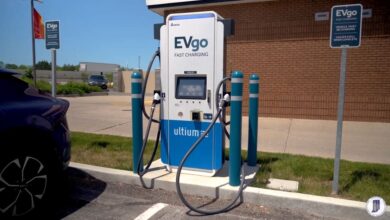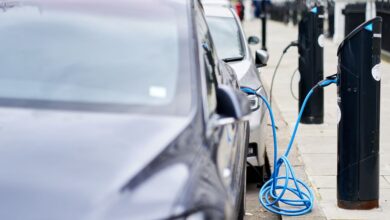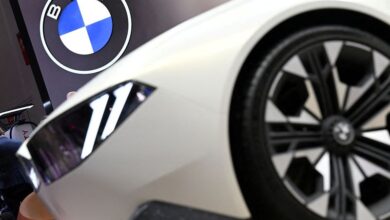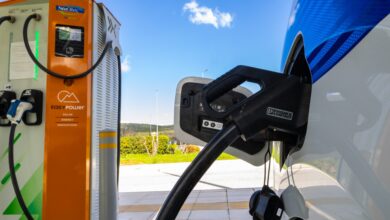Arkansas Accelerates EV Infrastructure Overhaul with $54M
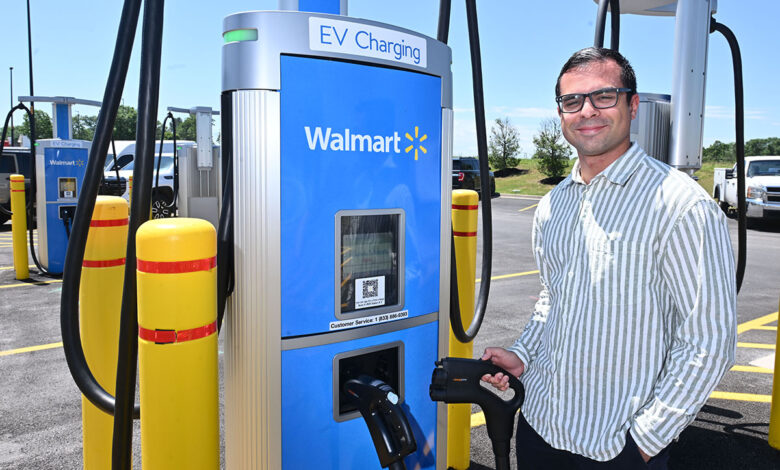
Aaron Pinedo, a senior engineer with the Arkansas Department of Transportation, is overseeing the state’s expansion of electric vehicle charging stations, an expansion that is being funded by $54 million in grants from the U.S. Department of Transportation’s National Electric Vehicle Infrastructure Formula Program. (Michael Woods)
The state’s threadbare electric vehicle infrastructure is undergoing a major upgrade thanks to $54 million from the federal government, but don’t expect to see a convoy of electric tractors rolling down the interstate anytime soon.
When President Joe Biden signed the Infrastructure Investment & Jobs Act in 2021, one of its provisions created the National Electric Vehicle Infrastructure Formula Program (NEVI). The U.S. Department of Transportation oversees the program, which is providing more than $5 billion in grants to help build out EV infrastructure nationally.
Arkansas will receive $54.1 million from the program to build NEVI-compliant electric charging stations throughout the state. The first 19 projects awarded this past year will cost nearly $15 million and are almost exclusively on the interstate system.
“That is the infrastructure we are focused on at the moment,” said Aaron Pinedo, a senior engineer with the Arkansas Department of Transportation. “We are federally required to have a charging station every 50 miles along the interstate system. In that aspect, we are lacking.”
Pinedo said the state has five NEVI-compliant charging stations: in Rogers, Hope, Little Rock, Clarksville and Forrest City. A NEVI-compliant station is one that has at least four fast-charging ports that can each deliver at least 150 kilowatts of electricity per hour.
For comparison, Pinedo said an average home uses 900 kilowatts a month.
Pinedo said each NEVI station costs approximately $1 million but ARDOT has several projects under budget. Some future locations may require fewer chargers, which can lower the cost.
The existing and future stations are primarily in locations such as gas stations, restaurants or grocery stores within 1 mile of the interstate. One of the 19 projects awarded by ARDOT is for a station in Siloam Springs on Highway 412, but the remaining 18 will be on interstates.
Electric Vehicle Infrastructure Development
Charging station projects approved by the Arkansas Department of Transportation
City |
Location |
Charging Ports |
Interstate |
Price |
| Caddo Valley | Pilot Travel Center | 4 | I-30 | $581,000 |
| Malvern | Love’s Travel Stop | 4 | I-30 | $753,000 |
| Morrilton | Casey’s | 4 | I-40 | $967,000 |
| Alma | Harps | 7 | I-40 | $479,000 |
| West Memphis | Petro Travel Center | 12 | I-40 | $943,000 |
| West Memphis | Cracker Barrel | 7 | I-40 | $516,000 |
| Conway | Cracker Barrel | 7 | I-40 | $516,000 |
| Lonoke | Circle K | 4 | I-40 | $498,000 |
| Russellville | Flying J Travel Center | 4 | I-40 | $668,000 |
| Hazen | Love’s Travel Stop | 4 | I-40 | $700,000 |
| Alma | Love’s Travel Stop | 4 | I-49 | $753,000 |
| Texarkana | EZ Mart | 4 | I-49 | $635,000 |
| Blytheville | Holiday Inn | 4 | I-49 | $1,016,000 |
| Osceola | Jordan’s Kwik Stop | 4 | I-55 | $1,068,000 |
| Pine Bluff | Southern Edge Truck Stop | 8 | I-530 | $1,753,000 |
| White Hall | Holiday Inn | 4 | I-530 | $597,000 |
| Jonesboro | Love’s Travel Stop | 4 | I-555 | $700,000 |
| Trumann | Flash Market | 4 | I-555 | $637,000 |
| Siloam Springs | Jiffy Trip | 4 | Hwy. 412 | $700,000 |
| Total | $14,916,000 |
Source: Arkansas Department of Transportation
The program calls for projects to be 80% funded by NEVI and 20% by private industry.
These chargers are for passenger vehicles and light trucks, allowing someone with an EV to fast-charge their vehicle while it is parked for an hour or two. Any state plans to expand its EV truck infrastructure will have to wait until it completes the current five-year NEVI program, which may take much longer than five years.
“When we receive the full funding, we’re not even going to be halfway done,” Pinedo said. “Even though we are receiving these funds every year once we submit a plan, this could be a 10-year [project]. This is a limited process because we can’t move on to the next phase until the ones we have awarded are fully open and operational.”
Trucking Industry Wary
The trucking industry, both nationally and statewide, has an ambivalent view of electric vehicles. Most companies are in favor of reducing emissions but balk at the stringent guidelines put forward by the U.S. Environmental Protection Agency.
The EPA has estimated that an annual 318 million tons of greenhouse gas emissions come from medium and heavy trucks. The EPA recently issued a rule requiring 30% of trucks to be zero emission by 2032, and the state of California is requiring half of all heavy trucks be electric by 2035.

“We in the trucking industry are very much in favor of reducing the environmental impact of transportation,” said Andrew Boyle, the chairman of the American Trucking Associations. “What is unfortunate is some people have tried to establish this binary decision between internal combustion engines that are dirty versus electrification. We feel that is a very short-sighted approach.
“Rather, we should reframe the argument in terms [of] we are all in favor of reducing the environmental impact of transportation. How can we do that with all the tools available to us?”
Boyle, the co-president of Boyle Transportation in Billerica, Massachusetts, will be the keynote speaker at the Arkansas Trucking Association’s annual conference this week in Rogers. Boyle has testified before the U.S. Congress about the limitations of EVs in the trucking sector.
Those limitations include the shorter range of electric vehicles between charges. In addition, electric vehicles are heavier because of their batteries, meaning they can carry less cargo, and electric tractors cost much more than a traditional diesel-fuel tractor. Shannon Newton, the Arkansas Trucking Association president, said research has shown that more than 15,000 chargers would have to be installed monthly during the next eight years to make EV trucking feasible.
“The charging infrastructure is nowhere near ready, nationwide or in Arkansas,” Newton said. “The very nature of our industry will require the entire country or at least a large portion of it to all come on line at the same time in order to support deployment. Just solving the problem in Arkansas won’t enable adoption of fleets engaged in interstate commerce, and similarly, if Arkansas is lagging behind, it will hinder adoption of fleets here and elsewhere.”
Other Tactics Suggested
Boyle and others agree that electric trucks have a role in the industry, such as in final- mile delivery in which a truck can make deliveries in a smaller footprint and be able to return to base for recharging. J.B. Hunt Transport Services Inc. of Lowell has used electric tractors in its final-mile division for several years.
But Boyle said implementing EVs across the board in trucking would require a massive infrastructure expansion in a country where truck drivers are already struggling to find places to park. Electrifying everything, Boyle said, would cost trillions of dollars.
Industry leaders say there are ways to reduce greenhouse gas emissions without using electric vehicles such as using renewable diesel as fuel.
J.B. Hunt incoming CEO Shelley Simpson said the company has already reached halfway to its goal of reducing emissions by 32% by 2034. J.B. Hunt said using intermodal as the primary form of transportation can reduce emissions by 60%.
Few transportation companies have the intermodal resources J.B. Hunt has, but trucking officials say that new diesel engines run much cleaner than those from 15 years ago. Boyle said overhauling and modernizing the nation’s fleet, which still has thousands of pre-2010 diesel engines, could reduce emissions by 40%.

“The trucking industry has recognized the importance of reducing emissions and our environmental impact,” Newton said. “Quite frankly, it sometimes feels like the work that has been done is dismissed and the goal post moved again to the impossible.
“Mandates and fictional timelines are unlikely solutions to additional emission reductions.”
Of course, many of the older tractors are still on the road because one- and two-truck operators can’t afford new tractors. Boyle said eliminating the 12% excise tax on tractor purchases could make the modernization more affordable than a total EV conversion.
“There are levers we can use. Whether they are tax credits or repealing the federal excise tax, there are ways to help those smaller fleets get to today’s standards that are much more cost efficient than the trillions it would cost to electrify everything,” Boyle said.
“We need to get away from the dogma associated with EVs being a panacea for environmental ills … we all can [agree] to the fact of the virtue of reducing environmental impact and we can do that [through] a multitude of options. I’m not even sold necessarily on the fact that [EV] is the holy grail. It is one of many means we can use.”
